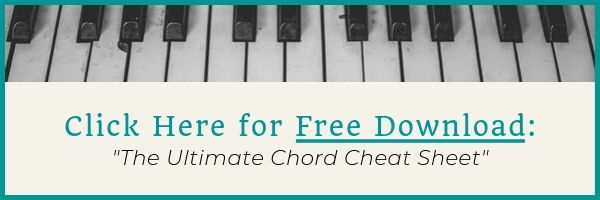How to Play E7 Piano Chord
The E7 piano chord pops up when you leave the very beginner stages of piano chords and start playing in keys like E major and A major. The E7 chord is a seventh chord and an important chord to know.
Below, you'll find we cover:
- E7 Piano Chord Notes
- How to Play E7 on Piano
- E7 Piano Chord Finger Positions
- E7sus4 Piano Chord
- E7/G# Piano Chord
- E7 Chord Piano Formula (Chord Theory)
E7 Piano Chord Notes
The notes of the E7 chord are: E G# B D.
E7 is a seventh chord and that's why we have the D as part of this chord. Otherwise it would just be an E chord.
To help you remember this chord, you can think of is as an E major chord plus D.
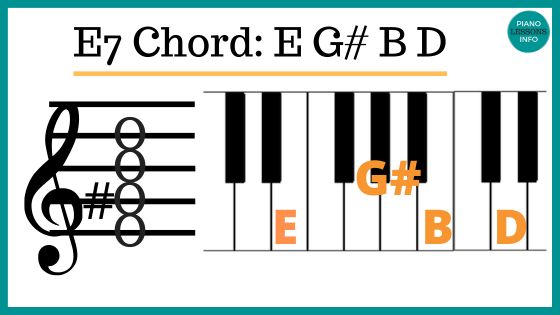
So now that you know the notes of this big 4 note chord ... which hand do you play the notes in? There are a few options:
1. Play the entire E7 chord in your right hand and E in your left hand.
2. Play the melody in the right hand and the E7 chord in your left hand, keeping E as the lowest note.
3. Play bits of the E7 chord in each hand. Keep E as the lowest note.
4. Play melody and parts of the E7 chord in the right hand and E plus other notes from the chord (if you want to) in your left hand.
There's no real right way or wrong way to play the notes in each hand so you can experiment and see what works for you.
How to Play E7 on Piano
This video will show you how to play the E7 chord on piano and what it should sound like.
E7 Piano Chord Finger Positions
The E7 chord tends to feel like a stretch for many people when they first start to play it. If that is you, just keep going and you'll get used to it. Your hand will adjust.
To play the E7 chord, you can use fingers 1, 2, 4, and 5 in your left hand or your right hand. This is everything but your middle finger.
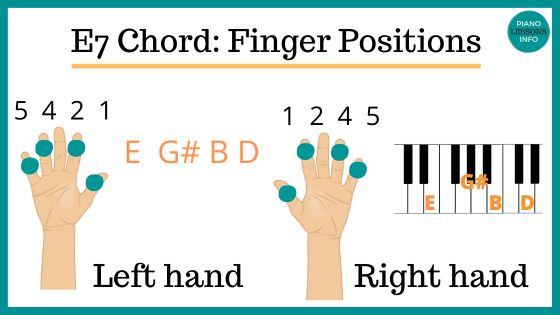
Remember that you don't have to play the E7 chord only in this position. You just need to play the notes somewhere on the piano. But it is easier learning chords in root position like this first.
E7sus4 Piano Chord
Another chord that is very similar to the E7 chord is the E7sus4 chord. This is also know as E suspended seventh chord.
This chord could also be written (correctly or incorrectly) like this:
- E7sus
- Esus7
- E7-4 (which could also mean lower the 4th)
Suspended chords are really the one type of chord that can be written a few different ways and that includes the suspended seventh.
I've covered all my bases by calling this chord the E7sus4 and the notes of the chord are: E A B D.
This is basically a suspended E chord (E4 / Esus / Esus4) with D (the 7th) added on top.
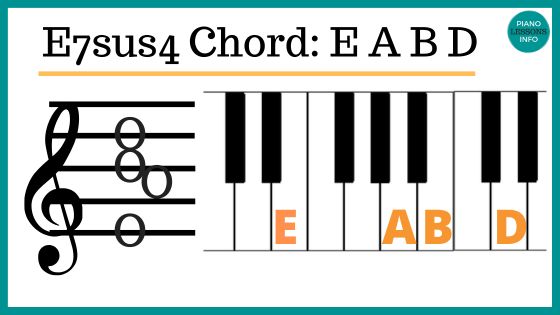
E7/G# Piano Chord
Another chord that pops up commonly enough to mention it here is the E7/G# piano chord. When you see E7/G#, it means to play G# as the lowest note in your left hand.
This is a slash chord and in any slash chord, which ever note comes after the slash is your bass note. So all of the notes of the E7 chord need to come above this and G# needs to be be played lowest.
E7 Chord Piano Formula (Chord Theory)
You can figure out any seventh chord by using the chord formula for seventh chords.
Chord formulas use the major scale and the number in the chord formula corresponds with the degree on the major scale.
The chord formula for all seventh chords is: 1, 3, 5 b7
So when we look at the E7 chord, we want to use the E major scale.
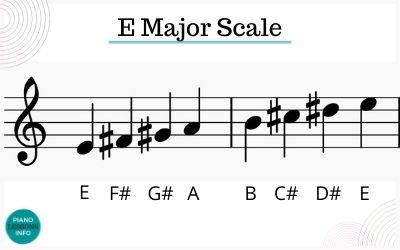
From there we take the first, third, fifth and lowered seventh notes of the E major scale which are:
1 = E
3 = G#
5 = B
b7 = D (D# becomes D because we lower the seventh)
If you want to learn more about seventh chords, click here. Or if you need to look up more chords, visit the Piano Chord Charts page or download your own copy below.
Free Download:
Ultimate Chord Cheat Sheet

Subscribe below and get free access to the (printable) Ultimate Chord Cheat Sheet.
Recent Articles
-
Piano Notes Chart
Nov 20, 23 10:21 PM
Find a piano notes chart for treble clef and bass clef notes as well as the different types of notes. -
D Chord on Piano + Diagram, How To & Theory
Oct 24, 23 12:20 AM
Learn how to play the D chord on piano with diagram, fingering, D/A, D/F# and a theory explainer. -
Diminished Piano Chords: Chart & How to Make Them
Oct 09, 23 09:23 PM
Learn the different diminished piano chords and how to make them. Here you'll find both a diminished chord chart and an explanation.
- Home
- 14 Day Chord Challenge
- E7 Piano Chord
Free Download:
Ultimate Chord Cheat Sheet

Subscribe below and get free access to the (printable) Ultimate Chord Cheat Sheet.




